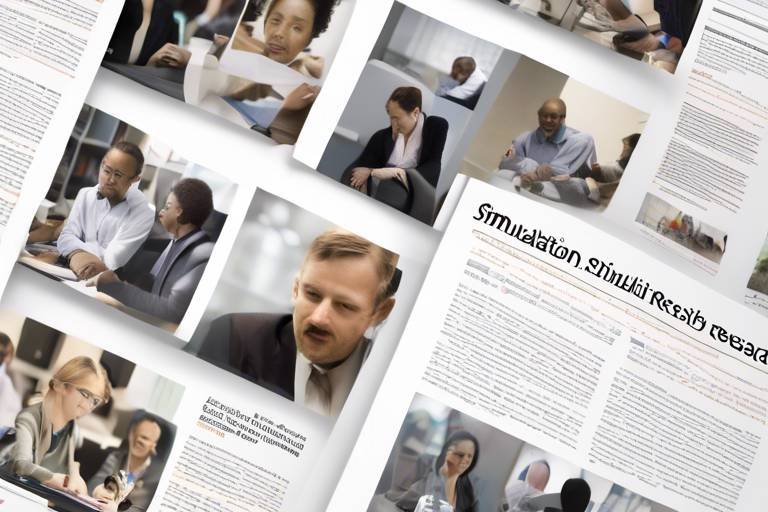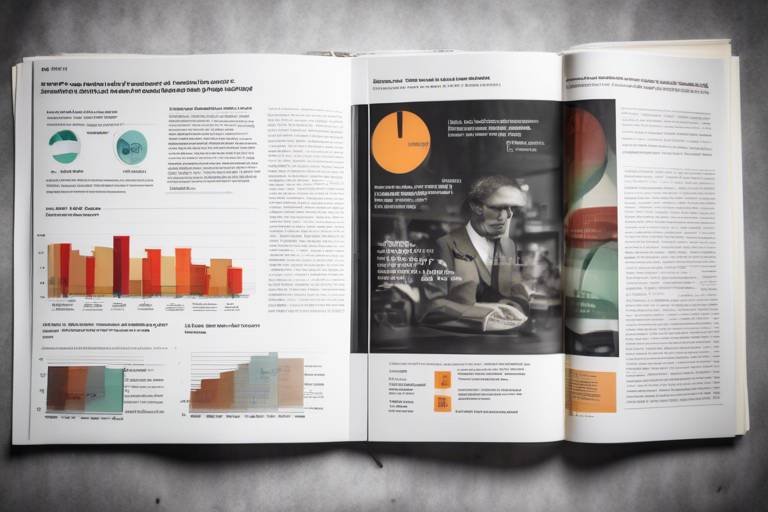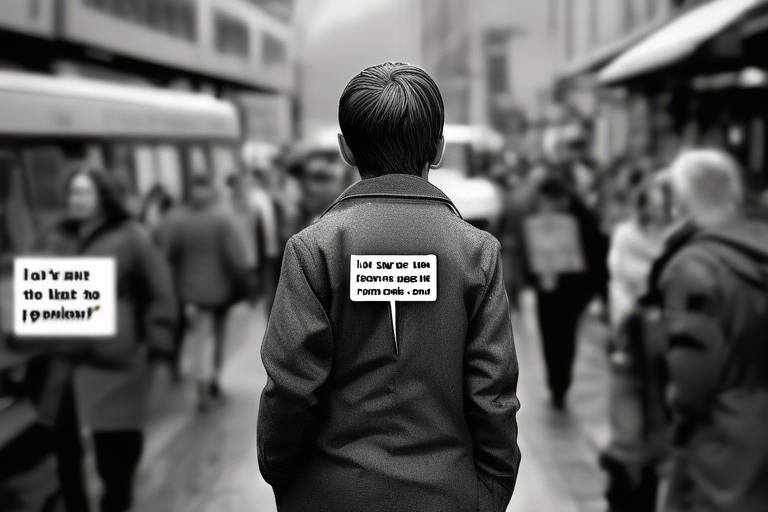How to Leverage User Experience Research in Product Design
User experience research is not just a trendy buzzword in the design world; it’s a crucial element that can make or break a product. Imagine trying to navigate a complex maze without a map—frustrating, right? That’s exactly how users feel when products are designed without understanding their needs and behaviors. By leveraging user experience research, designers can create products that not only meet user expectations but also delight them. This article dives deep into the significance of user experience research, exploring various methods, benefits, and best practices for effectively integrating user insights into the design strategy.
Understanding user needs and behaviors is at the heart of successful product design. User experience research serves as the foundation for making informed design decisions. Without this research, products can end up being misaligned with what users actually want or need. This can lead to wasted resources, increased costs, and ultimately, product failure in a competitive market. By prioritizing user experience research, designers can ensure their products are not only user-centric but also more likely to succeed. Think of it as a compass that guides the design process, helping teams navigate the complexities of user preferences and market demands.
There are numerous methods available for conducting user experience research, each offering unique insights that can significantly enhance product design. Some of the most effective methods include:
- Surveys and Questionnaires: These are powerful tools for gathering quantitative data, allowing designers to reach a larger audience and efficiently understand user preferences and pain points.
- Interviews: One-on-one discussions with users provide in-depth qualitative insights, revealing the motivations behind user behaviors.
- Usability Testing: Observing real users as they interact with a product uncovers usability issues and provides direct feedback on design effectiveness.
- Observation: Watching users in their natural environment can unveil insights that surveys and interviews might miss.
Each of these methods can be tailored to fit the specific needs of a project, ensuring that designers gather the most relevant and actionable insights.
Surveys and questionnaires are effective tools for gathering quantitative data. They allow designers to reach a larger audience and understand user preferences and pain points efficiently. However, the key to a successful survey lies in its design.
Creating well-structured surveys is crucial for obtaining valuable insights. Clear questions and a logical flow help ensure that participants provide meaningful responses that can inform design choices. For instance, instead of asking, “Do you like our product?” it’s more effective to ask, “What features do you find most useful in our product?” This shift not only encourages more detailed feedback but also helps identify specific areas for improvement.
Analyzing survey results involves interpreting data to identify trends and patterns. This analysis helps designers prioritize features that align with user needs and expectations. By using tools like spreadsheets or specialized software, designers can visualize data through charts and graphs, making it easier to draw conclusions. For example, if a significant number of users express confusion about a particular feature, it may signal the need for redesign or additional user education.
Usability testing is another invaluable method in user experience research. It involves observing real users as they interact with a product, revealing usability issues and providing direct feedback on design effectiveness. This method allows designers to see firsthand how users navigate their products, which can lead to targeted improvements. Imagine having a sneak peek into the mind of your users—what they like, what they struggle with, and what they absolutely love. That’s the power of usability testing!
Incorporating user research findings into the design process is essential for creating user-centered products. It fosters collaboration between designers and researchers, ensuring that user insights drive design decisions. This integration can be achieved through various methods, including:
Collaborative design workshops bring together cross-functional teams to brainstorm and refine ideas based on user research. This approach encourages creativity and ensures diverse perspectives are considered, leading to more innovative solutions. During these workshops, teams can share insights from their respective areas, creating a richer understanding of user needs.
Iterative design involves continuously refining products based on user feedback. Establishing feedback loops allows designers to adapt and improve designs, ultimately enhancing user satisfaction and product success. Think of it like sculpting a statue; each iteration brings you closer to the final masterpiece, shaped by the insights and preferences of your users.
Q: What is user experience research?
A: User experience research is the process of understanding user needs, behaviors, and motivations through various methods, such as surveys, interviews, and usability testing.
Q: Why is user experience research important in product design?
A: It ensures that products are user-centric, enhancing user satisfaction and increasing the likelihood of product success in a competitive market.
Q: What are some common methods of user experience research?
A: Common methods include surveys, interviews, usability testing, and observation.
Q: How can I effectively analyze survey results?
A: Use tools to visualize data, looking for trends and patterns that can inform design decisions.
Q: What is iterative design?
A: Iterative design is the process of continuously refining a product based on user feedback to improve its usability and effectiveness.

The Importance of User Experience Research
User experience research is not just a fancy term thrown around in design meetings; it's a crucial element that can make or break a product. Imagine you’re crafting a beautiful piece of art, but if no one understands its meaning, what’s the point? Similarly, without user experience research, your product might look great on the surface but fail to resonate with the people who matter most—your users. By diving deep into user needs and behaviors, this research informs design decisions that ensure products are not only functional but also delightful to use.
Why is this so important? Well, consider the competitive landscape of today’s market. With countless products vying for attention, understanding your users can give you a significant edge. When you base your design on solid user insights, you create a product that feels tailored to your audience, enhancing their overall experience. This leads to higher satisfaction rates, increased loyalty, and ultimately, better sales. In fact, a study by Forrester Research found that every dollar invested in user experience returns $100, highlighting the tangible benefits of prioritizing user needs.
Moreover, user experience research allows designers to identify potential pain points early in the design process. This proactive approach can save time and resources by addressing issues before they escalate into costly mistakes. Think of it as a safety net that catches problems before they fall through the cracks. By understanding what users find challenging or confusing, designers can make informed choices that enhance usability and accessibility.
Incorporating user experience research also fosters a culture of empathy within design teams. When designers engage with users and understand their perspectives, they are better equipped to advocate for their needs throughout the design process. This collaboration often leads to innovative solutions that might not have been considered otherwise. After all, who knows better about the challenges users face than the users themselves?
In summary, user experience research is essential for creating products that not only meet user expectations but also exceed them. It transforms the design process from a guessing game into a strategic endeavor rooted in real-world insights. By investing in user research, companies can ensure their products are not just functional but also resonate deeply with their audience, paving the way for success in an ever-evolving market.

Methods of User Experience Research
User experience research is a treasure trove of insights that can significantly influence product design. By employing various research methods, designers can dive deep into the minds of users, uncovering their needs, preferences, and pain points. Each method offers a unique lens through which to view the user experience, making it essential to choose the right approach for your specific goals. Let's explore some of the most effective methods of user experience research that can elevate your design process.
One of the most popular methods is surveys and questionnaires. These tools are fantastic for gathering quantitative data from a larger audience, allowing designers to identify trends and common issues among users. Imagine throwing a wide net into the ocean of potential users and reeling in valuable insights about their preferences and pain points. However, crafting effective surveys requires skill. Clear, concise questions paired with a logical flow can ensure participants provide meaningful responses. To illustrate this, consider the following table that outlines key elements of an effective survey:
| Element | Description |
|---|---|
| Clarity | Questions should be straightforward and easy to understand. |
| Relevance | Each question should be pertinent to the research objectives. |
| Logical Flow | Organize questions in a way that feels natural to the participant. |
| Variety | Use a mix of question types (multiple choice, open-ended) to gather diverse insights. |
Once the surveys are completed, the next step is to analyze the results. This process involves interpreting the data to identify trends and patterns. For instance, if a significant percentage of users express frustration with a particular feature, designers should prioritize addressing that issue. This analysis not only informs design choices but also helps in aligning product features with user expectations.
Another crucial method is usability testing. This technique involves observing real users as they interact with a product, providing direct feedback on usability issues and design effectiveness. Picture this: a group of users navigating your product while you watch, taking mental notes of where they struggle or succeed. This firsthand observation can lead to targeted improvements that enhance the overall user experience. During usability testing, it’s essential to create a comfortable environment where users feel free to express their thoughts and opinions. This can be achieved through moderated sessions, where a facilitator guides users through tasks while encouraging open dialogue.
In addition to surveys and usability testing, interviews and observational studies are also valuable methods. Interviews allow for in-depth conversations, enabling researchers to delve into users' motivations and emotions. On the other hand, observational studies provide insights into how users interact with products in their natural environment, revealing behaviors that may not surface in a controlled setting.
Ultimately, the effectiveness of user experience research lies in its ability to inform design decisions. By leveraging these methods, designers can create products that resonate with users, ensuring a more user-centric approach. As we move forward, integrating these insights into the design process becomes paramount for achieving success in a competitive marketplace.

Surveys and Questionnaires
When it comes to understanding user preferences and pain points, are like golden tickets. They allow designers to gather quantitative data from a broad audience, making it easier to spot trends and patterns that might otherwise go unnoticed. Imagine trying to navigate a crowded marketplace without any signs or maps—surveys provide the necessary direction, helping product designers hone in on what users truly want.
These tools can be designed to elicit a variety of responses, from multiple-choice questions that yield quick insights to open-ended questions that invite detailed feedback. The beauty of surveys lies in their versatility; they can be distributed online, via email, or even on social media platforms, reaching users wherever they are. This broad reach is crucial in today’s fast-paced digital environment where user opinions can shift in the blink of an eye.
However, crafting an effective survey is an art form in itself. The design of the survey plays a pivotal role in the quality of the data collected. A well-structured survey should include:
- Clear and concise questions: Avoid jargon and keep language simple to ensure that all participants understand what is being asked.
- Logical flow: Organize questions in a way that feels natural, guiding participants through the survey without confusion.
- Variety in question types: Mix multiple-choice, Likert scale, and open-ended questions to capture both quantitative and qualitative data.
Once the surveys are completed, the real fun begins—analyzing the results. This step is where designers can sift through the responses to identify trends that may inform design choices. For example, if a significant number of respondents express frustration with a specific feature, this insight can lead to targeted improvements. Using data analysis tools can aid in visualizing this information, making it easier to present findings to stakeholders.
In summary, surveys and questionnaires are invaluable tools in the user experience research toolkit. They not only help in gathering essential data but also empower designers to create products that resonate with users on a deeper level. By integrating user feedback into the design process, companies can significantly increase their chances of launching successful products that meet real-world needs.
Q1: How long should a survey be?
A: Ideally, a survey should take no longer than 10-15 minutes to complete. This duration keeps participants engaged without causing fatigue.
Q2: What is the best way to distribute surveys?
A: Online platforms such as SurveyMonkey, Google Forms, or social media channels are effective ways to reach a wide audience quickly.
Q3: How can I ensure a high response rate?
A: To boost response rates, consider offering incentives, keeping surveys short, and sending reminders to participants.
Q4: Can surveys be used for qualitative research?
A: Absolutely! Open-ended questions within surveys can provide qualitative insights that enrich the quantitative data.

Designing Effective Surveys
Creating effective surveys is an art that can significantly impact the quality of insights you gather. It's not just about throwing together a bunch of questions and hoping for the best; it requires careful thought and planning. Think of your survey as a conversation with your users—one that should flow naturally and encourage honest, thoughtful responses. To achieve this, you need to focus on a few key elements.
First and foremost, clarity is crucial. Your questions should be straightforward and free from jargon. Imagine asking a friend for their opinion on a movie; if you use complicated language or reference obscure concepts, they might not understand what you're asking. Similarly, when designing your survey, ensure that each question is easily understandable. This clarity helps avoid confusion and ensures that respondents provide meaningful answers.
Next, consider the structure of your survey. A logical flow will guide respondents through the questionnaire smoothly, making it less likely for them to lose interest or become frustrated. Start with general questions to warm them up, then gradually move towards more specific inquiries. This technique not only keeps the respondents engaged but also helps you gather more nuanced data.
Another vital aspect is the type of questions you choose to include. Open-ended questions can provide rich qualitative data, allowing respondents to express their thoughts in their own words. However, they can be difficult to analyze. On the other hand, closed-ended questions, such as multiple-choice or rating scales, are easier to quantify and analyze. A balanced mix of both types can yield comprehensive insights. For example:
| Question Type | Purpose | Example |
|---|---|---|
| Open-ended | Gather detailed feedback | What do you like most about our product? |
| Closed-ended | Quantify responses | On a scale of 1-5, how satisfied are you with our product? |
Lastly, consider the length of your survey. While it might be tempting to ask as many questions as possible to gather extensive data, be mindful of your respondents' time. A survey that takes too long can lead to fatigue and incomplete responses. Aim for brevity while still capturing the essential information you need. A good rule of thumb is to keep your survey under 10 minutes. You can also include progress indicators to show respondents how far along they are, which can help keep them motivated to complete the survey.
By paying attention to clarity, structure, question types, and length, you can design surveys that not only yield valuable insights but also make the process enjoyable for your respondents. Remember, the goal is to foster a dialogue with your users and to understand their needs better. So, take the time to craft your surveys thoughtfully, and you'll be rewarded with data that can truly inform your product design decisions.
- What is the ideal length for a survey? Aim for under 10 minutes to keep respondents engaged.
- How can I encourage more responses? Offer incentives or ensure your survey is easy to access and complete.
- What types of questions should I include? A mix of open-ended and closed-ended questions works best.

Analyzing Survey Results
Once your surveys are complete and responses are collected, the real fun begins: analyzing the results. This stage is crucial because it transforms raw data into actionable insights that can significantly impact your product design. But how do you go from a pile of numbers to a clear direction for your design? Let’s break it down.
First, you’ll want to organize the data. This means categorizing responses based on common themes or user sentiments. For instance, if you asked users about their favorite product features, you might find that many respondents mention ease of use or aesthetic appeal. By grouping these responses, you can start to see which features are most valued by your audience.
Next, you should identify trends and patterns. This is where the magic happens! Look for recurring feedback that stands out. For example, if a significant number of users express frustration with a specific functionality, that’s a clear indicator that something needs to change. You might consider using data visualization tools, like charts or graphs, to make these trends more digestible. A simple table could look something like this:
| Feature | Positive Feedback (%) | Negative Feedback (%) |
|---|---|---|
| Ease of Use | 85% | 5% |
| Aesthetic Appeal | 75% | 10% |
| Loading Speed | 60% | 30% |
In this example, you can see that while "Ease of Use" is a strong point, "Loading Speed" could use some serious attention. This highlights the areas where your design can be improved and where users are most satisfied.
Another critical aspect of analyzing survey results is prioritizing features. Not all feedback is created equal. You’ll need to determine which insights are most relevant to your product goals and user needs. Consider the following when prioritizing:
- Frequency of feedback: How many users mentioned this issue or feature?
- Impact on user experience: How does this feature affect overall satisfaction?
- Alignment with business objectives: Does this feedback support your product vision?
By weighing these factors, you can create a roadmap for your design improvements that not only meets user expectations but also aligns with your business strategy.
Finally, don’t forget to share your findings with your team. Transparency in the design process fosters collaboration and ensures everyone is on the same page. Create a presentation or a report that summarizes the key insights from your survey analysis, and encourage team discussions around these findings. This collaborative approach can lead to innovative solutions and a more user-centered product.
Q: How can I ensure my survey questions are effective?
A: Focus on clarity and relevance. Use straightforward language and avoid leading questions. Pilot testing your survey with a small group can also help refine your questions.
Q: What tools can I use for analyzing survey data?
A: There are many tools available, such as Google Forms for data collection and software like Excel, Tableau, or specialized survey analysis platforms for data analysis.
Q: How often should I conduct user experience surveys?
A: It depends on your product lifecycle. Regular surveys can be beneficial, especially after major updates or before launching new features, to ensure you stay aligned with user needs.

Usability Testing
Usability testing is a crucial step in the product design process that allows designers to observe real users interacting with their products. Imagine watching someone try to solve a puzzle while you hold the pieces; their struggles and successes reveal insights that no amount of guesswork could provide. This method not only highlights usability issues but also offers direct feedback on the effectiveness of design elements. By placing users at the center of the testing process, designers can identify pain points, confusion, and areas where the product excels or falls short.
During usability testing, participants are typically asked to complete specific tasks while observers take notes on their behavior and reactions. This can be done in a controlled environment or remotely, depending on the resources available. The key is to create a comfortable setting where users feel free to express their thoughts and frustrations openly. Think of it as inviting someone into your home to try out a new gadget; you want them to feel at ease so you can truly understand how they interact with it.
The benefits of usability testing are manifold. Here are a few:
- Identifying User Pain Points: By observing users, you can pinpoint exactly where they struggle, allowing you to make targeted improvements.
- Validating Design Choices: Testing helps confirm whether your design decisions resonate with users or if adjustments are necessary.
- Enhancing User Satisfaction: A product that is easy to use leads to happier customers, which can translate into better reviews and increased sales.
To conduct effective usability testing, follow these best practices:
- Define Clear Objectives: Know what you want to learn from the testing session. Are you validating a specific feature or assessing overall usability?
- Recruit the Right Participants: Ensure your test group represents your target audience to gather relevant insights.
- Facilitate, Don’t Interfere: Let users explore the product independently while you observe. Interject only when necessary to clarify tasks.
After conducting usability tests, analyzing the data collected is essential. Look for patterns in the feedback and behaviors observed. For instance, if multiple users struggle with a particular feature, it’s a clear signal that changes are needed. By synthesizing this information, designers can prioritize which aspects of the product require immediate attention. The iterative nature of usability testing means that it’s not a one-off event; rather, it should be integrated into the design process, allowing for continuous improvement.
In conclusion, usability testing is not just a checkbox in the product development process; it’s a vital tool for creating user-centric designs. By understanding how real users interact with your product, you can make informed decisions that lead to better usability, higher satisfaction, and ultimately, greater success in the market.
1. What is usability testing?
Usability testing is a method used to evaluate a product by testing it with real users. Participants are asked to complete tasks while observers watch, listen, and take notes. This helps identify usability issues and gather direct feedback.
2. How do I conduct usability testing?
To conduct usability testing, define clear objectives, recruit participants that represent your target audience, and facilitate the testing session without interfering. Record observations and analyze the data afterward.
3. What are the benefits of usability testing?
Usability testing helps identify user pain points, validate design choices, and enhance overall user satisfaction, leading to better products and increased customer loyalty.
4. How often should I conduct usability testing?
Usability testing should be an ongoing process throughout the product development cycle. Regular testing allows for continuous improvement and adaptation based on user feedback.

Integrating User Research into Design Process
Integrating user research into the design process is more than just a checkbox to tick off; it’s a fundamental shift toward creating products that genuinely resonate with users. When designers embrace user insights, they’re not merely guessing what users want; they’re crafting experiences that align with actual needs and preferences. This alignment is crucial in today’s fast-paced market, where consumer expectations are higher than ever. So, how do we truly integrate user research into our design process?
First and foremost, collaboration is key. Designers should actively work alongside researchers to ensure that user insights are woven into every stage of the design process. This collaboration can take many forms, such as regular meetings to discuss findings, brainstorming sessions to generate ideas based on user feedback, and even workshops that focus on refining concepts. By fostering an environment where designers and researchers communicate openly, teams can create a more cohesive approach to product development.
Another effective strategy is to establish iterative design cycles. This involves creating prototypes and then testing them with real users to gather feedback. Rather than waiting until the end of the design phase to unveil a product, designers should continuously seek input and make adjustments along the way. This method not only enhances the end product but also builds a culture of responsiveness to user needs. Users appreciate when their feedback is acknowledged and implemented, which can lead to stronger brand loyalty.
To facilitate this process, consider implementing feedback loops. These loops allow designers to gather insights at various stages, ensuring that user perspectives are consistently considered. For instance, after a usability test, designers can analyze the feedback and make necessary adjustments before moving on to the next phase. This cyclical approach not only improves the product but also instills confidence among team members that they are on the right track.
Additionally, leveraging tools such as user personas can significantly enhance the integration of user research. User personas are fictional characters created based on real user data, representing different segments of your audience. They help keep the team focused on user needs throughout the design process. By referring to these personas during brainstorming sessions, designers can ensure that their ideas are grounded in reality and tailored to actual users.
Moreover, conducting collaborative design workshops can be incredibly beneficial. These workshops bring together cross-functional teams, including designers, researchers, and stakeholders, to brainstorm ideas based on user research findings. This approach not only encourages creativity but also ensures that diverse perspectives are considered, leading to more innovative solutions. During these workshops, teams can utilize various techniques such as sketching, storyboarding, and role-playing to visualize concepts and drive engagement.
In conclusion, integrating user research into the design process is an ongoing journey that requires commitment and collaboration. By embracing user insights, fostering an iterative design culture, and utilizing tools like user personas and collaborative workshops, designers can create products that not only meet but exceed user expectations. This approach not only enhances user satisfaction but also significantly boosts the chances of product success in a competitive landscape.
- What is user experience research?
User experience research involves studying how users interact with a product to understand their needs, preferences, and pain points. This research informs design decisions to create user-centered products.
- How can I conduct user experience research?
You can conduct user experience research through various methods, including surveys, interviews, usability testing, and observational studies.
- Why is collaboration important in the design process?
Collaboration ensures that diverse perspectives are considered, leading to more innovative solutions and a stronger alignment with user needs.
- What are feedback loops?
Feedback loops are processes that allow designers to gather user insights at various stages of the design process, ensuring continuous improvement based on real user input.

Collaborative Design Workshops
Collaborative design workshops serve as a dynamic platform where teams come together to explore innovative ideas and refine concepts based on user research. Imagine a melting pot of creativity, where designers, researchers, and stakeholders gather to brainstorm solutions that are not only functional but also resonate deeply with users. These workshops are essential for fostering an environment where diverse perspectives can flourish, leading to richer design outcomes.
During these workshops, participants engage in various activities that encourage open dialogue and collaboration. Techniques such as brainstorming sessions, sketching, and role-playing are employed to stimulate creative thinking. By incorporating user insights gathered from previous research, teams can challenge assumptions and explore new avenues that may not have been considered otherwise. This collaborative effort ensures that every voice is heard, and that the final design reflects a comprehensive understanding of user needs.
One of the key benefits of collaborative design workshops is the ability to quickly iterate on ideas. As suggestions are made and feedback is provided, teams can adapt their designs in real-time. This iterative process not only enhances creativity but also helps in identifying potential pitfalls early on, saving time and resources in the long run. For instance, if a particular design element doesn't resonate with users during the workshop, the team can pivot and explore alternatives immediately, rather than waiting until later stages of development.
To further illustrate the effectiveness of collaborative design workshops, consider the following table that outlines the key components of a successful workshop:
| Component | Description |
|---|---|
| Cross-Functional Teams | Bringing together individuals from different departments to provide diverse insights. |
| User Research Insights | Utilizing findings from user experience research to inform discussions and decisions. |
| Creative Techniques | Employing brainstorming, sketching, and prototyping to encourage idea generation. |
| Real-Time Feedback | Facilitating immediate input on ideas to refine and improve designs on the spot. |
In conclusion, collaborative design workshops are not just meetings; they are vibrant sessions that breathe life into the design process. By harnessing the collective knowledge and creativity of a group, designers can create products that are not only innovative but also deeply aligned with user needs. So, the next time you're embarking on a design project, consider organizing a collaborative workshop. It could be the spark that ignites your team's creativity and leads to a truly user-centered product.
- What is the main goal of a collaborative design workshop?
The primary goal is to bring together diverse perspectives to brainstorm and refine ideas based on user research, ensuring that the final design is user-centric. - Who should participate in these workshops?
Ideally, participants should include designers, researchers, stakeholders, and even users to gain a holistic view of the design challenges. - How long should a collaborative design workshop last?
The duration can vary, but most workshops last between 2 to 4 hours, allowing enough time for discussion and iteration without causing fatigue. - What techniques can be used during the workshop?
Techniques such as brainstorming, sketching, role-playing, and prototyping are commonly used to encourage creativity and collaboration.

Iterative Design and Feedback Loops
Iterative design is not just a buzzword; it's a fundamental approach that can significantly enhance the quality of your product. Think of it as a continuous cycle where you design, test, gather feedback, and refine your product. This process is akin to sculpting a statue; each chisel stroke reveals more of the masterpiece hidden within the marble. By embracing iterative design, you’re not only creating a product but also fostering a culture of adaptability and responsiveness to user needs.
At the heart of iterative design are feedback loops. They serve as the lifeblood of your design process, providing the necessary insights to make informed decisions. By establishing regular intervals for feedback, you can ensure that your design evolves in alignment with user expectations. Imagine trying to navigate a ship without a compass; feedback loops act as that compass, guiding your design in the right direction.
To implement effective feedback loops, consider the following key steps:
- Engage Users Early: Involve users from the beginning stages of your design. Their early insights can help shape your product's direction.
- Conduct Regular Testing: Schedule usability tests at various stages of development. This allows you to catch issues before they become major problems.
- Solicit Diverse Feedback: Gather input from a wide range of users. Different perspectives can uncover insights you might otherwise overlook.
- Analyze and Act: After collecting feedback, analyze the data to identify trends. Be ready to pivot your design based on these insights.
One of the most effective ways to visualize the iterative process is through a simple table that outlines the stages of iterative design:
| Stage | Description | Outcome |
|---|---|---|
| Design | Create initial design concepts based on user research. | Prototype ready for testing. |
| Test | Conduct usability tests with real users. | Gathered feedback on design effectiveness. |
| Analyze | Review feedback and identify areas for improvement. | Insights for refining the design. |
| Refine | Make necessary adjustments to the design. | Improved prototype ready for re-testing. |
By following this iterative cycle, you can ensure that your product remains relevant and user-friendly. It’s not about getting it perfect on the first go; rather, it’s about embracing the journey of continuous improvement. Remember, the goal is to create a product that resonates with users, and that can only be achieved through constant engagement and adaptation.
Q1: What is iterative design?
Iterative design is a cyclical process where a product is designed, tested, and refined based on user feedback. This approach helps improve the product continuously, ensuring it meets user needs effectively.
Q2: How often should I gather feedback?
Feedback should be gathered at multiple stages throughout the design process. Regular testing and feedback sessions can help identify issues early and guide the design in the right direction.
Q3: Can I use automated tools for feedback?
Yes, automated tools can be beneficial for collecting feedback, especially surveys and analytics. However, it's also important to conduct live usability tests to gain deeper insights.
Q4: What if user feedback contradicts my design vision?
It's essential to balance user feedback with your design vision. While user insights are crucial, consider the overall goals of your product and how feedback aligns with those objectives.
Frequently Asked Questions
- What is user experience research?
User experience research is a process that helps designers understand how users interact with a product. It involves gathering insights about user needs, behaviors, and pain points, which can significantly inform and enhance the design process.
- Why is user experience research important in product design?
User experience research is crucial because it ensures that products are designed with the user in mind. By understanding user needs and preferences, designers can create products that are not only functional but also enjoyable to use, increasing the likelihood of success in the market.
- What methods are commonly used for user experience research?
Common methods include surveys, interviews, usability testing, and observation. Each of these methods provides different insights and can be used in combination to gather a comprehensive understanding of user experiences.
- How do I design effective surveys for user research?
To design effective surveys, focus on clear and concise questions that flow logically. Avoid jargon and ensure that questions are easy to understand. This helps participants provide meaningful responses that can inform your design decisions.
- What is usability testing and why is it important?
Usability testing involves observing real users as they interact with a product to identify usability issues. This method is important because it provides direct feedback on how well the design meets user needs, allowing for targeted improvements.
- How can I integrate user research into the design process?
Integrating user research involves collaborating with cross-functional teams and using insights to guide design decisions. Regular feedback loops and iterative design processes ensure that user feedback continuously shapes the product.
- What are collaborative design workshops?
Collaborative design workshops are sessions where diverse teams come together to brainstorm and refine ideas based on user research. This approach fosters creativity and ensures that multiple perspectives are considered in the design process.
- What is iterative design?
Iterative design is a process where products are continuously refined based on user feedback. This allows designers to adapt and improve their designs over time, enhancing user satisfaction and the overall success of the product.



















